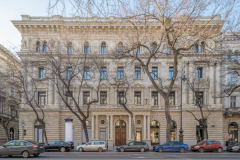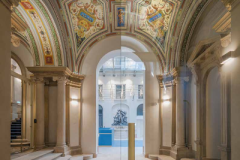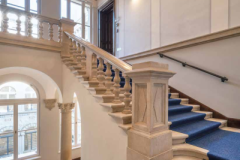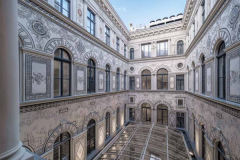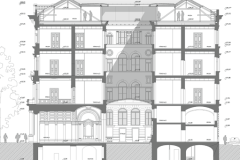Restoring a Sense of Home
Krausz Palace, Budapest
Architect: Péter Bordás
Text: Gabriella Uhl
Photos: Tamás Bujnovszky
This grandiose building with its lavish design and decoration was built by Lajos Krausz in 1882. The first floor was then occupied by the Krausz family, whilst the other floors were rented apartments for the upper middle classes, and the ground floor housed shops and famous cafés. The building was renovated for the first time in 2002, a project taking into account its architectural heritage, on the basis of plans by Tamás Kőnig and Péter Wágner. At that time, the magnificent frescoes and sgraffito were exposed and renewed, and the original structure was partially restored, whilst the inner courtyard was closed off with a glass roof to make room for a modern office building. The new interior design of the lobby and the use of materials reflect the revivalist neo-Renaissance decoration, the blue terrazzo cladding has been inspired by the decoration, the custom-designed lamp-cloud matches the old-new components of the palace regarding both forms and materials, and the airiness reflects the lightness of the Renaissance sense of life, while offering perfect visibility and lighting for the inner reception area and the courtyard. An ingenious solution by Bord Architect Studio reflects the ever-changing meaning of public and private space by breaking with the solid gateway design and closing and opening the house to the citydwellers and tourists walking along Andrássy Avenue with a completely transparent glass surface. Zsigmond Quittner had a keen interest in intimacy, comfort and the creation of his own (family) space, and thus he found a solution to this issue, taking into account the needs of his urban life at the end of the 19th century. The team managed by Péter Bordás has translated this idea into the present: comfort here is characterised by modern, silent and precise engineering, the ingenuous construction of which is the most important component of the current renovation project.
Client: PKD Hungary Investment
Project management: Realiscon
General plans: BORD Architectural Studio
Leading architect: Péter Bordás
Project architect: Kata Zih
Fellow architects: Péter Bukovszky, Róbert Gulyás, Noémi Gyárfás, Balázs Móser, Viola Tóth
HVAC: Zoltán Hollókövi – BORD Studio
Monument history documentation: Judit Janotti Dr
Structure: István Kerek – Kerek és Pintér
Electrical engineering: Kornél Mátyus – Lead Design
Architect of the renovation in 2001: Kőnig and Wagner Architects

